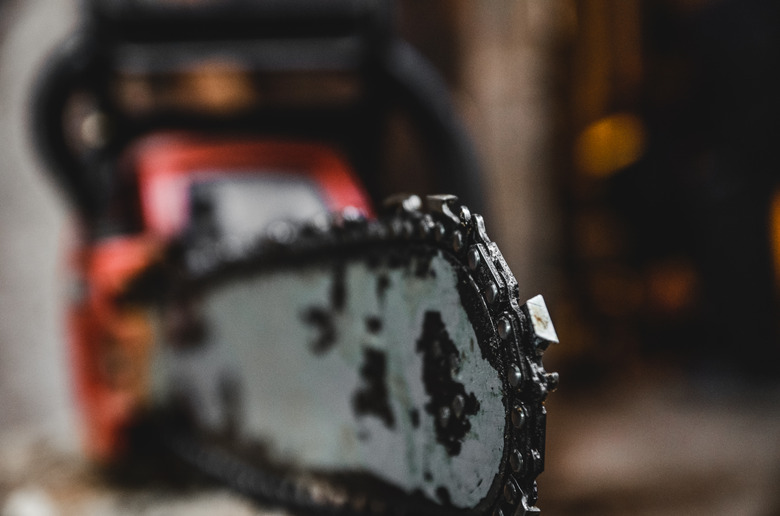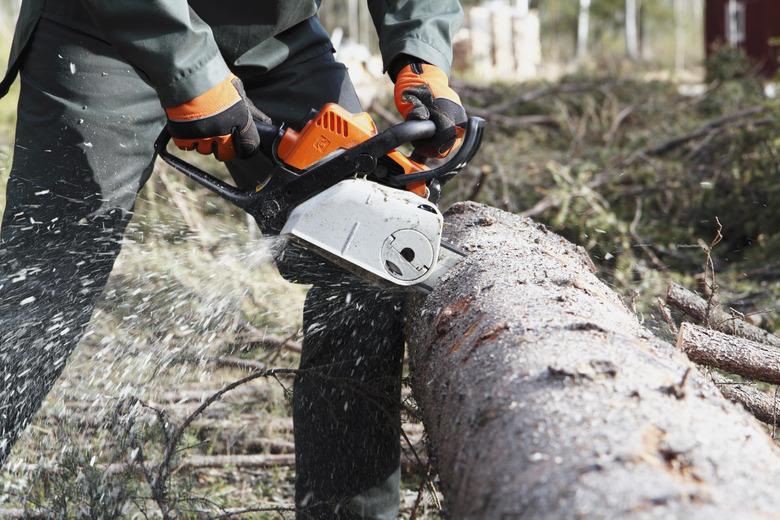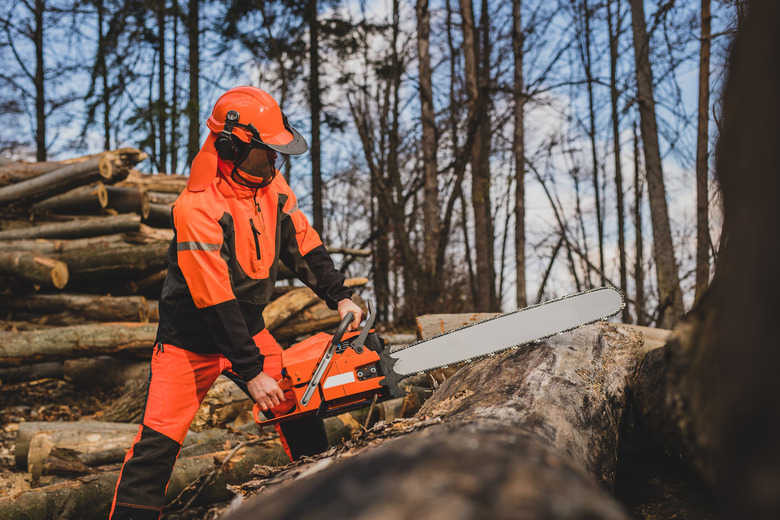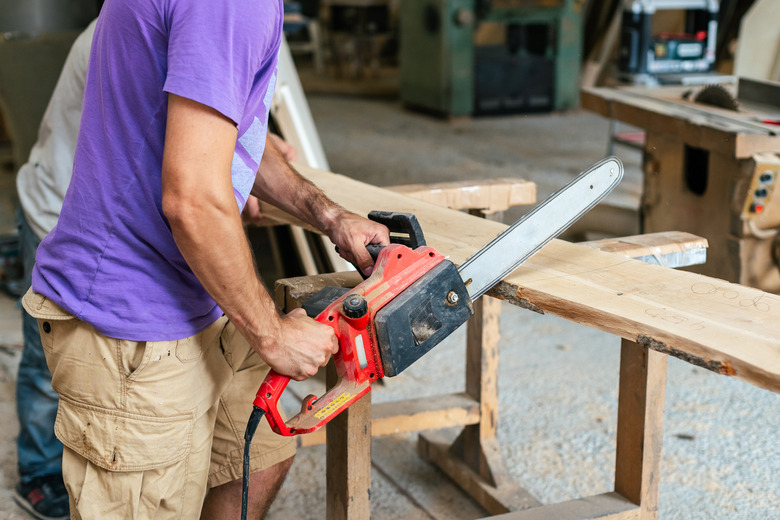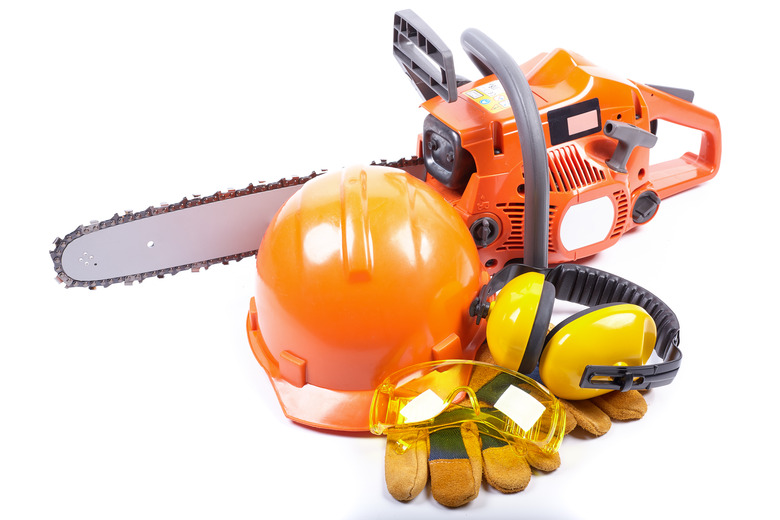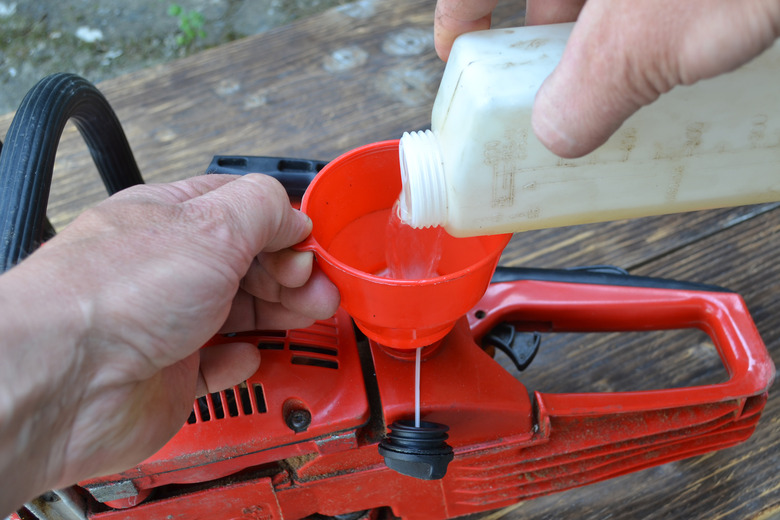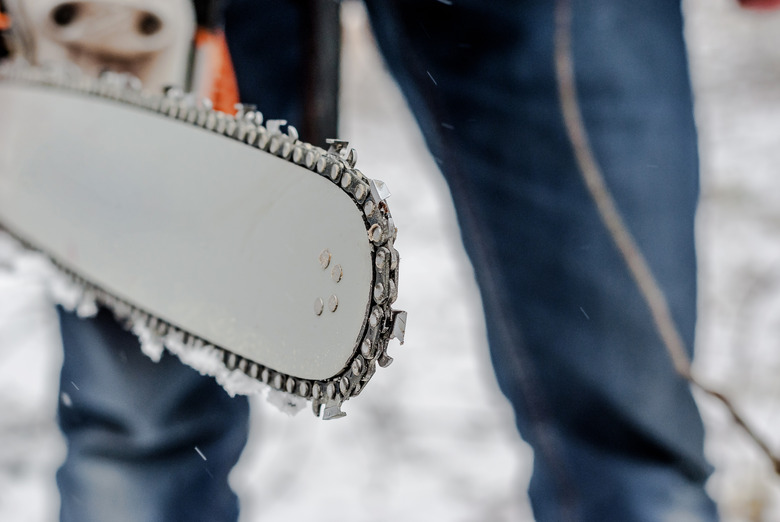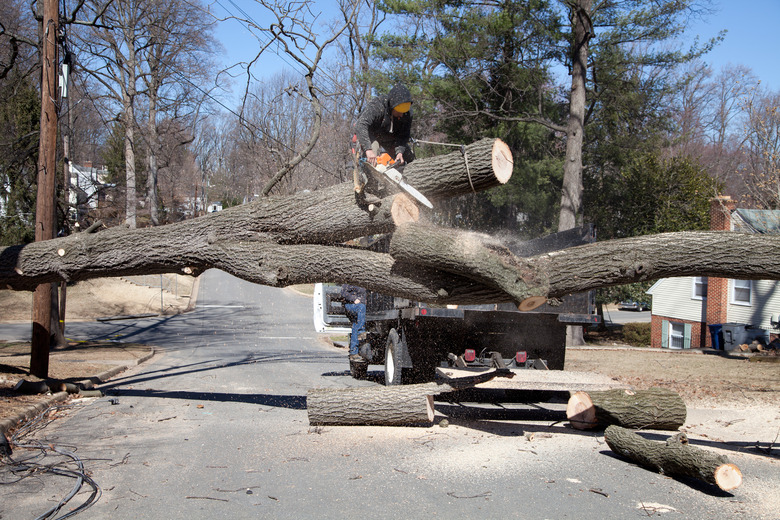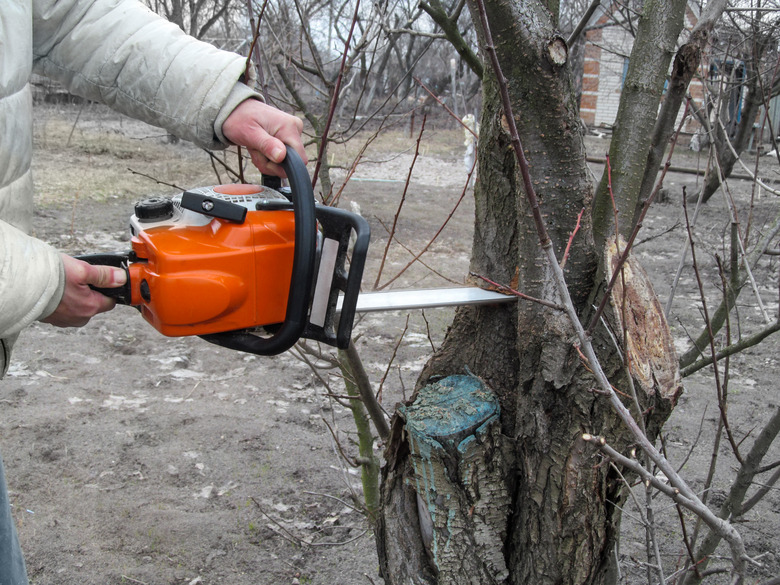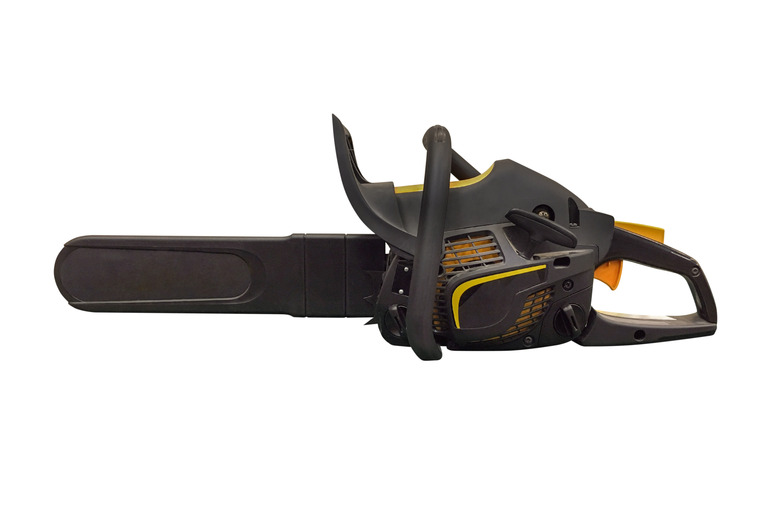Tips For Using A Chainsaw
A chainsaw is one of the most dangerous implements you can own without a license, and its ability to wreak havoc is well documented in horror movies or from tales from emergency room staff members. Chainsaws are also among the most useful tools out there, though, and when the job calls for one, nothing else will do. No other tool can slice through a 12-inch tree trunk in a single swipe. If you had a circular saw that could do it, it would be far more dangerous than a chainsaw, and you could forget about using it for any other job.
The most important tips for using such a dangerous tool as a chainsaw have to do with using it safely. Besides those, all users can benefit from a few pointers on usage and maintenance. Contractor-grade chainsaws are gasoline-powered with often-finicky engines, so if you have limited experience using one, you need to know a few things to ensure that it starts up and stays running when you need it.
Many people use chainsaws out in the forest, and when an accident happens out there, it can happen quickly, so perhaps the most important safety tip is to avoid working alone. Always wear protective gear, including chaps, a helmet with a faceplate and gloves. Wear bright-colored gear, so you're easy to spot, and avoid loose-fitting clothing.
How Chainsaws Work
How Chainsaws Work
A chainsaw doesn't have a blade. The cutting is done by a chain connected by a gear to the motor and traveling around a flat, detachable bar. The teeth on the chain do the actual cutting, and they need to be sharpened regularly to keep the saw in good working order. Chainsaw motors have traditionally been gas-powered, but you can buy electric ones intended primarily for around-the-house jobs, such as pruning. Recently, even battery-powered models have made their way to the store shelves.
To keep a chainsaw in good working order, you have to maintain the engine, which is more challenging for gas-powered models than electric ones. You also have to lubricate the chain, and every saw has a port for chain lubricant. This is in addition to the engine oil, which typically gets added to the gas. One of the most important safety devices on a chainsaw is the chain brake, which is usually positioned in front of the front handle. It should be engaged—that is, pushed out toward the end of the bar—whenever you start the engine. k
Tip #1: Avoid the Kickback Zone
Tip #1: Avoid the Kickback Zone
You can cut with the bottom of the chain by pushing down against the wood, and you can cut using the top of the chain by pulling up with the chain and bar positioned below the branh or log. There is one spot that should not come in contact with the work, though, and that's the small section of the chain at the tip of the bar toward the top. This is the kickback zone.
The motion of the chain at this particular spot puts torque on the entire saw when the chain contacts something, and the saw can snap back at you suddenly and forcefully. You can get cut or, if you're working on unstable ground, you can lose your balance. Avoid either outcome by making sure the tip of the saw passes beyond the far edge of the wood you're cutting.
Tip #2: Keep Your Work Below Shoulder Height
Tip #2: Keep Your Work Below Shoulder Height
A chainsaw is fairly heavy, and it's easy to lose control when you're trying to cut something over your head. Kickbacks are also common in such a situation. It may take a little extra effort, but make sure you position your body so the wood you're cutting is at least below your shoulders. As a bonus, you'll find cutting more comfortable, and you won't tire as easily. If you need to cut something over your head, do it with a different type of saw.
Tip #3: Use the Right Saw for the Job
Tip #3: Use the Right Saw for the Job
Chainsaws come with a variety of bar lengths, from under 20 inches to over 48 inches. When felling trees or bucking up logs for firewood, you need a bar long enough to pass through the work, and saws with longer bars need more powerful engines, so they are heavier. You don't need such a long, powerful, heavy saw for pruning, so don't waste your energy using a big saw when a smaller, lighter saw will do the job.
Tip #4: Hold and Carry the Saw Properly
Tip #4: Hold and Carry the Saw Properly
It goes without saying that you need to hold a chainsaw with both hands when working. One hand is on the trigger while the other is holding the front handle with an encircling grip, which means the thumb is wrapped completely around the handle.
You don't have to stop the saw whenever you have to move to another area, but you should definitely take your hand off the trigger. Hold the saw by the front handle and suspend it so the bar is parallel to the ground. The motor can continue to idle but the blade will be motionless.
Tip #5: Adopt a Comfortable Cutting Stance
Tip #5: Adopt a Comfortable Cutting Stance
You will save energy by letting the saw do most of the work, but even so, you still need to apply some upward or downward pressure, or you'll be there all day. The most comfortable stance is one with both feet planted firmly on the ground and your legs slightly spread.
Keep the saw tilted slightly upward to prevent touching the earth, or "kissing the ground," with the front of the chain, which dulls the chain and can cause kickback. As further insurance against kickback, keep the saw over to one side—not directly in front of you.
Tip #6: Protect Your Ears
Tip #6: Protect Your Ears
People who do a lot of work with chainsaws always wear ear plugs or ear muffs. This isn't as important for a homeowner pruning a few tree branches, but it's still a good idea, especially if always use other power tools regularly. Ear damage from high-decibel noise is progressive, and you might not notice it until it's too late. Don't risk it.
Tip #7: Put Stabilizer in the Fuel—Always
Tip #7: Put Stabilizer in the Fuel—Always
One of the most common reasons for a trip to the repair shop is old fuel. It collects in the carburetor and gums it up, and the chainsaw won't start. Fuel stabilizer keeps fuel healthy by preventing the fuel from absorbing moisture. It's common to forget to add it after you've already poured fuel into the chainsaw's gas tank, so do it when you're mixing the fuel with oil in the fuel can.
Even with stabilizer, fuel tends to degrade over time, so the longest you should leave it in the saw is about 4 weeks. Empty out all the fuel if you expect the saw to remain idle for a longer period, especially in cold or humid weather.
Tip #8: Fill the Gas and Bar Lubricant Before Each Use
Tip #8: Fill the Gas and Bar Lubricant Before Each Use
You need to add gas, or the saw won't run, but it's just as important to keep the chain lubricant topped up. If you forget, and the saw runs out, the heat of friction will damage the chain and possibly the motor.
Tip #9: Stop Often and Check the Chain
Tip #9: Stop Often and Check the Chain
Chainsaw chains dull fairly quickly, and a dull chain will cost you time and extra effort. When the chain is sharp, the waste material from the cut will be fairly large pieces of sawdust, but these gradually turn into a fine dust as the blade dulls, and that's when you know that the chain needs sharpening.
It's especially important to check the chain after kissing the ground. Don't forget to also check the chain tension and adjust it if necessary. At the proper tension, you should be able to just barely slide a penny between the chain and the bar.
Tip #10: Pay Attention to Your Surroundings
Tip #10: Pay Attention to Your Surroundings
When using a chainsaw outside the house or in the woods, keep an eye out for hazards that could cause a slip or something more serious. Some things to watch for are utility lines, branches or objects that could fall on you. If you're felling a tree, be sure to scout out an escape route and to take note of conditions, such as high winds, that could cause the tree to fall in an unexpected direction.
Tip #11: Pay Attention to What You're Cutting
Tip #11: Pay Attention to What You're Cutting
When you need a chainsaw, it's often because you're cutting live wood or wood that hasn't dried out yet. Note whether the wood comes from a part of the tree with an irregular grain that could bind the saw. When cutting large branches, prepare for the moment when the branch breaks at the cut line so you can pull out the saw and prevent it from binding. When working in gardens or on farms, keep an eye out for metal objects, such as fencing, stakes or braces so you don't hit them with the saw.
Tip #12: Cover the Chain When You Store the Saw
Tip #12: Cover the Chain When You Store the Saw
The chain can rust if left exposed to the elements, so every chainsaw comes with a chain cover. Use it whenever you store the saw. This is also a safety issue—it protects everyone from coming in contact with the chain and possibly getting cut.
If you lost the cover that came with your chainsaw, you can use one from another manufacturer, as long as it's designed for the same size bar. You can also improvise a cover with some foam rubber pipe insulation and some string. Wrap the insulation around the entire bar, inserting the cutting teeth in the slit in the insulation, then tie string around the blade to hold the insulation in place.
